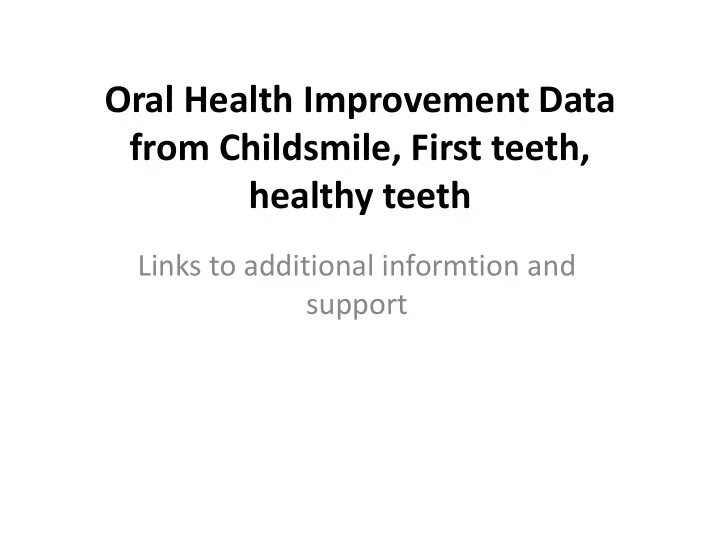

Oral Health Improvement Data from Childsmile, First teeth, healthy teeth Links to additional informtion and support
The Policy - Childsmile An Action Plan for Improving Oral Health and Modernising Dental Services in Scotland (Scottish Executive 2005) The Action Plan outlined the Scottish Government’s target for NHS Health Boards, stating that 60% of five -year-old children should be decay free by 2010 and this target was met. It also promoted a shift in balance of care towards prevention rather than treatment by targeting the early years age group. Better Health, Better Care: Action Plan (Scottish Government 2007) Better Health, Better Care announced that Childsmile would be ‘rolled out as a new schools based prevention dental service’ incorporating fluoride varnish applications to children’s teeth and fissure sealants applied as appropriate. Equally Well: Report of the Ministerial Task Force on Health Inequalities (Scottish Government 2008) Equally Well emphasises its commitment to children’s dental health during the early years. Getting it Right for Every Child (Scottish Government 2008b) Getting it Right for Every Child (GIRFEC) places children’s and young people’s needs first. It ensures that they are listened to and understand any/all decisions affecting them and they receive more coordinated help where required for their wellbeing, health and development. It requires that all services for children and young people – social work, health, education, police, housing and voluntary organisations – improve how they work together to support children and young people. The integration of Childsmile within mainstream national child health programmes helps ensure child dental health is part of normal offer of service.
The Policy – Childsmile Con’t Early Years Framework (Scottish Government 2009) This framework seeks to shift the focus of service provision to early identification and early intervention; these philosophies fit well with the Childsmile Programme. Health for all Children 4: Guidance on implementation in Scotland (Scottish Executive 2005) Reflects a move away from a wholly medical model of screening for disorders, towards greater emphasis on health promotion, primary prevention and targeting effort on active intervention for children and families at risk.Version 2.5 date amended: March 2014 review date: Feb 2015 7 A New Look at HALL 4: The Early Years, Good Health for every Child (Scottish Government 2011) Supplements Health for all Children 4 and reframes its commitment in light of subsequent policy commitments such as Getting it Right for Every Child, The Early Years Framework, Equally Well and Achieving our Potential. It has three main areas of focus; identification of need, delivery of early preventive advice and support and reintroduction of a 24 month review. This review will allow us to develop a complementary oral health review point on the Childsmile pathway. Improving Maternal and Infant Nutrition: A Framework for Action (Scottish Government 2011) Framework for Action focuses on improving the nutrition of mothers in pregnancy and infant nutrition in Scotlandcovering a minimum period of 10 years. Areas of focus include: supporting parents with information on infant feeding, complementary feeding and early eating patterns and supporting women to initiate and continue breastfeeding. A coordinated, multi-agency, multi-faceted approach is highlighted.
Oral Health Evidence • The development of Childsmile was underpinned by SIGN Guideline 47 (2000) and SIGN Guideline 83 (2005). Between them, they presented the case for a programme which embraced the roles of a wide range of professionals in prevention of decay through evidence based activity. This included supervised toothbrushing, twice yearly fluoride varnish application, community based oral health promotion and regular visits to the dental team. • These guidance documents have been superseded by SIGN Guideline 138 (2014) which focuses on one to one interventions carried out by the dental team with children and young people aged 0-18 years.
Oral Health Evidence cont • The Scottish Dental Clinical Effectiveness Programme Guidance, on the Prevention and Management of Dental Caries in Children (SDCEP 2010) presents clear and consistent advice to support dental professionals deliver preventive care and, where necessary, manage caries. • The latest Cochrane Systematic Review (Marinho et al. 2013) highlights the benefits of fluoride varnish extend to all children, if applied systematically across all age groups. Oral Health and Nutrition Guidance for Professionals (2012) • The purpose of this guidance is to provide agreed, consistent, evidence- based guidance on oral health and nutrition for professionals. The guidance provides clear oral health and nutrition advice for the whole population. A special focus is given to the under-5s as intervention in the earliest years is vital for improved outcomes in the short and long term and will positively impact across the life course.
Recommend
More recommend